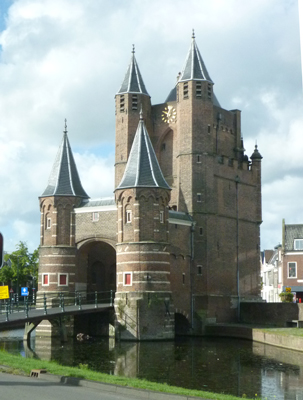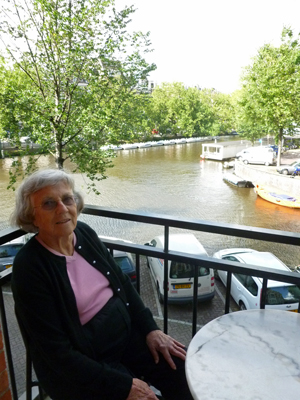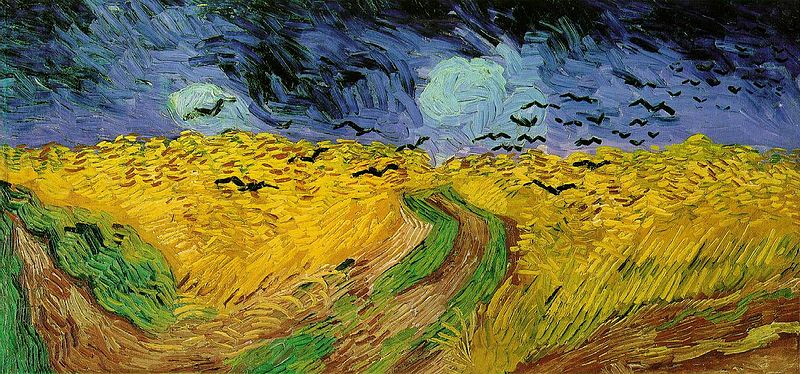|
We had breakfast in the hotel and then took a taxi to Amsterdam. On the way out of Haarlem we saw an old city gate, called the Amsterdam Gate since the road that went through it went to Amsterdam. We had a pleasant ride through the countryside and then into the busy area of Amsterdam. Our room was not yet ready so we walked to the flower market on one of the canals. We also bought some stroopwaffels, a small Dutch waffle with syrup in it and two broodjes (breads), one with a cheese we really like, Leidsekase, and the other with good ham. |  |
 |
When we got back to the hotel our room was ready and we went to see it and were very pleased. Besides a very nice room there was a balcony with a view of a large canal. There is a lot of activity on the canal, since many of the canal boats have it as part of their route. The hotel is in an excellent location, within easy walking distance of the Rijksmuseum and the Van Gogh Museum. |
Since the Rijksmuseum is closed on Mondays, we decided to go to the Van Gogh Museum, which has recently been reorganized. One section of his life is covers the years of Van Gogh's life from 1880-1885. In 1880, Vincent Van Gogh decided to become an artist. He was 27 years of at the time, and had already worked in a variety of professions: as an art dealer, a teacher, and as an assistant minister, but without success. He took some instruction from a relative, Anton Mauve, who was one of the artists of the Hague School. In a letter to his brother Theo Van Gogh in December 1881, he wrote "I'm still going to Mauve's every day, during the day to paint, in the evenings to draw. Have now painted 5 studies and 2 watercolours..."
1885 was an especially productive year for Vincent. Listings of his works include over 150 works painted during that year.
A second period of his life (1885-1888) may be called the Paris years. Vincent's brother Theo wrote to Vincent to tell him about a new style of painting in Paris called Impressionism. In 1886 Vincent moved to Paris to learn from these new painters. His art became influenced by painters such as Claude Monet, Edgar Degas and Camille Pissarro. He also became good friends with artist Paul Gauguin.
During this time van Gogh began to use brighter colors. His brushwork also became more broken. He painted subjects from the streets and cafes of Paris as well as the countryside. Van Gogh also became interested in painting portraits of people. When he couldn't find models, he would paint himself for practice. He painted over twenty self portraits during this time.
A third period (1888-1889) may be called the Arles Years. In 1888 van Gogh moved south to Arles, France to start up an artist's commune. He rented out a yellow house to live in and invited artist Paul Gauguin to join him. He loved the vibrant colors and the bright sun of Arles. Van Gogh began painting with intensity and emotion. The colors in his paintings became more vibrant and bright. He would sometimes apply the paint directly onto the canvas from the tubes leaving the paint thick with rough brush strokes. Sometimes it would take weeks for his paintings to dry because the paint was so thick. Vincent painted hundreds of pictures during this time, sometimes painting masterpieces in a single day. He became fully obsessed with art. Paul Gauguin came to visit for a time, but the two artists had an argument and Gauguin soon left.
In 1889 van Gogh committed himself to a mental hospital and this may be called his Saint-Remy period. He could barely take care of himself. He still continued to paint and painted one of his most famous paintings Starry Night, which we saw at d'Orsay in Paris. Many of his paintings during this time featured cypress trees and lots of swirling colors.

Wheatfield with Crows is one of Van Gogh's most famous paintings and probably the one most subject to speculation. It was executed in July 1890, in the last weeks of Van Gogh's life. Many have claimed it was his last work, seeing the dramatic, cloudy sky filled with crows and the cut-off path as obvious portents of his coming end. However, since no letters are known from the period immediately preceding his death, we can only guess what his final work might really have been.
Van Gogh's mental state continued to deteriorate. On July 29, 1890 he died from a self-inflicted bullet wound to the chest.
Tomorrow Don goes to the Rijksmuseum to see some Hague School drawings in their study room and Elizabeth spends the day riding canal boats.
